
Agnolo Gaddi (c.1350–1396) was an Italian painter. He was born and died in Florence, and was the son of the painter Taddeo Gaddi, who was himself the major pupil of the Florentine master Giotto.
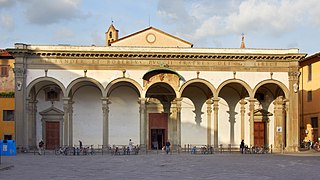
The Basilica della Santissima Annunziata is a Renaissance-style, Catholic minor basilica in Florence, region of Tuscany, Italy. This is considered the mother church of the Servite Order. It is located at the northeastern side of the Piazza Santissima Annunziata near the city center.

A doubting Thomas is a skeptic who refuses to believe without direct personal experience – a reference to the Gospel of John's depiction of the Apostle Thomas, who, in John's account, refused to believe the resurrected Jesus had appeared to the ten other apostles until he could see and feel Jesus's crucifixion wounds.

Prato is a city and comune (municipality) in Tuscany, Italy, and is the capital of the province of Prato. The city lies in the northeast of Tuscany, at an elevation of 65 metres (213 ft), at the foot of Monte Retaia. With 195,213 inhabitants as of 1 January 2023, Prato is Tuscany's second largest city and the third largest in Central Italy.

Ridolfo di Domenico Bigordi, better known as Ridolfo Ghirlandaio was an Italian Renaissance painter active mainly in Florence. He was the son of Domenico Ghirlandaio.

The Assumption of the Virgin Mary does not appear in the New Testament, but appears in apocryphal literature of the 3rd and 4th centuries, and by 1000 was widely believed in the Western Church, though not made formal Catholic dogma until 1950. It first became a popular subject in Western Christian art in the 12th century, along with other narrative scenes from the Life of the Virgin, and the Coronation of the Virgin. These "Marian" subjects were especially promoted by the Cistercian Order and Saint Bernard of Clairvaux.

Andrea della Robbia was an Italian Renaissance sculptor, especially in ceramics.

Prato Cathedral, or Cathedral of Saint Stephen, is a Roman Catholic cathedral in Prato, Tuscany, Central Italy, from 1954 the seat of the Bishop of Prato, having been previously, from 1653, a cathedral in the Diocese of Pistoia and Prato. It is dedicated to Saint Stephen, the first Christian martyr.

The image of La Madonna del Parto is a religious depiction of the Blessed Virgin Mary as pregnant which was popularised in Tuscany, Italy during the 14th—century.

Santa Maria della Scala is located in Siena, Italy. Now a museum, it was once an important civic hospital dedicated to caring for abandoned children, the poor, the sick, and pilgrims. Revenues were earned partially from bequests and donations from the citizens of Siena, particularly the wealthy. The head of the hospital was the rector who managed the lay brothers responsible for its operation.

The Cincture of the Theotokos is believed to be a relic of the Theotokos, now in the Vatopedi monastery on Mount Athos, which is venerated by the Holy Eastern Orthodox Church. The word "cincture" is sometimes also translated as "belt", "sash" or "girdle". Its feast day is September 13.

Volterra Cathedral is a Roman Catholic cathedral in Volterra, Italy, dedicated to the Assumption of the Virgin Mary. It is the seat of the bishop of Volterra.

E. A. E St. Mary's Soonoro Syriac Orthodox Church, Meenangadi, is a Marian Pilgrim center of the Syriac Orthodox Church located at Meenangadi in Kerala, India. The church is under E.A.E Arch Diocese, the first missionary association of Syriac Orthodox Patriarchate of Antioch and All the East, and is currently under the direct control of Ignatius Aphrem II, Patriarch of the Syriac Orthodox Church. In 2006, the church was elevated to the status of "Marian Pilgrim Centre", and in 2018, it celebrated its diamond jubilee. It is the first church to adopt the 8 Day Lent in Malabar Region.

Bartolomeo di Fruosino was an Italian Renaissance painter and illuminator of the Florentine School. Apart from illuminations, he mainly painted deschi da parto and cassone panels.

St. Mary's Jacobite Syrian Cathedral, located in Kollam District of Kerala also known as Gothara Idavaka preserved generation of Pakalomattam family who baptized by Saint Thomas, is a Jacobite Syrian Christian Church. As per tradition, Most church members belong to the Pakalomattom family known as Vilayil Tharakan Gothram, the part of the family branch communion.

The Holy Girdle, also known as the Girdle of Thomas, Holy Girdle of Mary, Holy Zoonoro, (or) Zunoro, and Holy Belt of Saint Mary the mother of Jesus, is a relic of the Blessed Virgin Mary which is one of the important relics of Syriac Orthodox Church and venerated by Oriental Orthodox communion. The word Zunoro is also translated as "belt", "sash" or "girdle".
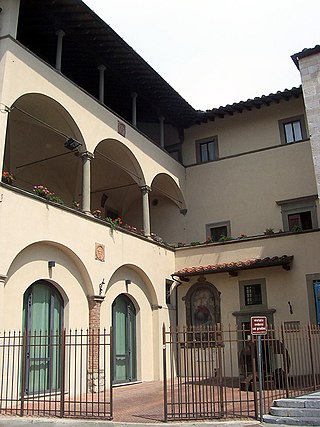
The Cathedral museum of Prato, Italy was founded in 1967 in a few rooms of the Bishop's residence and in 1976 grew to include items from both the Cathedral of Saint Stephen and the diocesan territory.
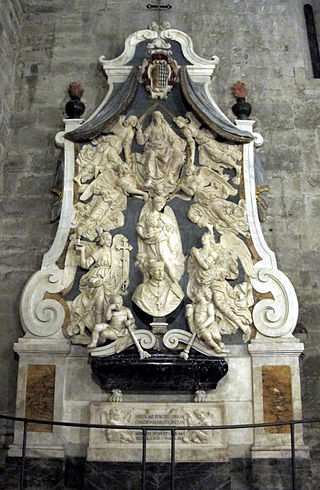
The Funerary Monument to Cardinal Niccolo Forteguerri is an assembly of mostly deep bas-relief sculptures installed posthumously on a wall of the Cathedral of Pistoia to memorialize the native Cardinal. While the initial design for this monument was completed by the Renaissance sculptor Andrea Verrochio, the present arrangement, completed centuries later, was assembled with substantial modifications by lesser-known artists.
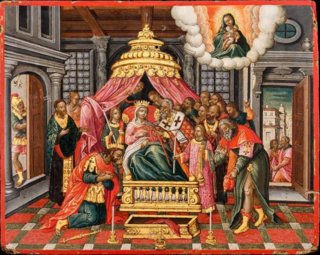
The Miracle of the Holy Belt was completed by Theodore Poulakis. He was a Greek painter originally from the village of Chania, Crete. He was associated with the Cretan School. He eventually migrated to the Ionian Islands. He was a member of the Heptanese School. He settled on the island of Corfu. He was a famous teacher. He signed a six-year contract to teach painting to Marinos Damistras son Tzorzi. The contract stipulated that his student had to follow him to Venice. Poulakis frequently traveled all over the Venetian Empire. During one period of his life, he stayed in Venice for over 13 years. He was very active within the painting community. He was also involved with the prestigious quarantia council. One hundred thirty of his work survived. The Girdle of Thomas also referred to as the miracle of the holy belt is a sacred relic located at Prato Cathedral in Tuscany, Italy.
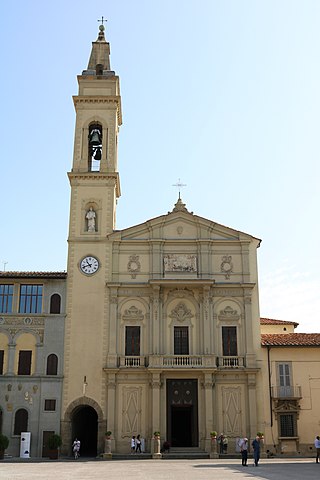
The Insigne Collegiata di San Lorenzo is a church in Piazza Varchi of central Montevarchi, Province of Arezzo, Tuscany, central Italy. Attached to the church is a small museum of sacred art, which includes a reconstructed chapel (tempietto) bedecked with panels by Andrea della Robbia.


































